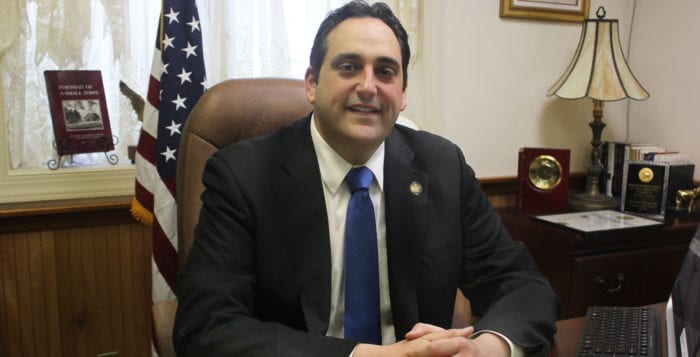Update: Bill Ferris dropped out of the race in July, there will be no primary to select a Republican candidate Sept. 12.
On the heels of Suffolk County District Attorney Tom Spota’s (D) decision to forgo a run at a fifth term this November, two Republicans and a Democrat, each longtime law enforcers, so far are publicly vying for the county’s top prosecutor job.
Spota, who assumed office in 2001, made his official announcement May 12, about a year after County Executive Steve Bellone (D) and several legislators called on him to resign from his position after playing a role in the promotion of former Suffolk County Chief of Police James Burke, who pleaded guilty in February 2016 to charges of a civil rights violation and conspiracy to obstruct justice.
“I want to be the next DA because I can make this county safe again.”
— Ray Perini
Accused of taking part in a police cover-up, which spurred on a federal investigation, Spota has been under scrutiny from both sides of the aisle for the last year. Spota shed light on his decision in an emailed statement through spokesman Robert Clifford.
“Be assured, this is one of the most difficult decisions I’ve ever made and my final decision was only made recently,” he said. “The deciding factor though, is that life is too short (especially at my age) and it’s time to spend quality time with my wife, children and grandchildren (with 2 more on the way!).”
With Spota out of the race, the torch will be passed on to a newcomer, of which there are three known contenders eyeing the seat — Ray Perini (R), former chief and founder of the Suffolk County District Attorney’s Narcotics Bureau; Bill Ferris (R), a Vietnam veteran and former assistant district attorney; and Tim Sini (D), current Suffolk County police commissioner — according to the Suffolk County Board of Elections. Each of them, as well as any others who decide to throw their hat in the ring, are expected to file petitions between July 10 and July 13.
Perini, 69, a Huntington resident, who entered the race in January, said he’s been training his entire career to be district attorney and wants to “take politics out of the DA’s office.”
“At this point in my career, I don’t want anything else,” Perini said. “I don’t want to be county executive, I don’t want to be governor, I don’t want to be judge … I want to be the next DA because I can make this county safe again.”
A highly experienced criminal lawyer with an active practice in Islandia, Perini has 43 years of experience in the criminal justice system, 17 of which were spent as a prosecutor bouncing from Brooklyn to Suffolk County, where he started the Narcotics Bureau in 1976.
In 1989, he went on to work with federal and state police agencies, including Suffolk County Police, the Drug Enforcement Administration, the FBI and drug task forces. He served as co-chair of the Suffolk County Criminal Bar Association’s criminal law committee and is a past president of the Suffolk County Criminal Bar Association.
“There is nothing I haven’t done in the criminal justice system,” Perini said. His major focuses if elected, he said, are gang violence and drug overdoses. “As a united front, working with the federal government, DEA, FBI and cops on the street, collectively, we can win this war [against drugs]. We need experience, this is what I’ve done, this is what I can do. All I care about is getting the job done.”
Perini ran unsuccessfully against Spota four years ago after the incumbent was cross-endorsed on all four party lines, for which Perini attacked Spota for not giving voters a choice at the polls.
“I wouldn’t accept a cross-endorsement,” the father of two said. “I want the voters to pick.”
“I want to restore the integrity and professionalism to the office, as well as faith in the judicial system and also in law enforcement.”
— Bill Ferris
Ferris, 70, a former Navy captain in the Vietnam war and Fordham Law School graduate from Southold, announced recently his intention to run against Perini, the choice of the Republican Party for the September primary.
“I want to restore the integrity and professionalism to the office, as well as faith in the judicial system and also in law enforcement,” Ferris, who served as prosecutor for 23 years under former Suffolk District Attorney Patrick Henry starting in 1978, said. “My background is clear and clean. I was in that office for 23 years and handled homicide, vehicular homicide, served on the Katie Beers [kidnapping] matter, tried a political corruption case against county sheriff Patrick Mahoney, served as president of the Suffolk County Bar Association recently, have taught young lawyers ethics and served on the Grievance Committee for Nassau and Suffolk for eight years.”
He said anyone who runs for the DA position has to have a clean record of integrity, accountability and professionalism, all of which the father of two said he has.
Among his biggest priority if elected, he said, is getting a handle on the gang situation that has left Suffolk residents feeling unsafe.
“I’ll protect the citizens, fight the gangs and give us back our good name,” Ferris said in a statement. “While I was in the DA office, we did have a gang unit, which was discounted under Mr. Spota … The DA’s office is in a critical position to bring in federal agency, state, and local police to put together a master plan to both investigate and prosecute gang members. Parents are afraid on a daily basis to send their kids to school and that should not happen in Suffolk County.”
Sini, 36, the youngest commissioner in the history of Suffolk County, announced his official run for the job on the same day Spota made his announcement, despite a claim in front of the county legislature in February 2016 before he was confirmed that he had no intentions of running for district attorney.
“[Tim Sini] stepped up to the plate and I think that’s exactly what we need.”
— David Kelley
“I think that when he said that he wouldn’t run, he meant what he said,” said David Kelley, former U.S. attorney for the Southern District of New York and chairman of Sini’s campaign. “Since then, a couple things have happened. Having the insight he does on the needs of the DA’s office and how the shape it’s in is so bad and such a disservice to the county, he could see that firsthand from his vantage point as commissioner from taking on difficult cases like MS-13, recognizing this office needs somebody who can be really good … he stepped up to the plate and I think that’s exactly what we need.”
Sini, who did not return multiple requests for comment through Kelley, has taken on the county’s gang violence and drug problem head-on in his short time in his position. He recently spoke before the U.S. Senate to outline the departments initiatives in tackling the county’s gang problem.
“If you take his commitments to public service and his professionalism, and put it together, he, by far, surpasses any of the other candidates and I think he’s exactly what the county needs,” Kelley said. “He’s a professional prosecutor, he’s spent a good part of his career in the U.S. Attorney’s office in Manhattan, he’s clerked for a federal judge, he’s a highly skilled and highly trained lawyer and prosecutor, and he also knows the ins and outs of the criminal justice system in Suffolk County.”




















